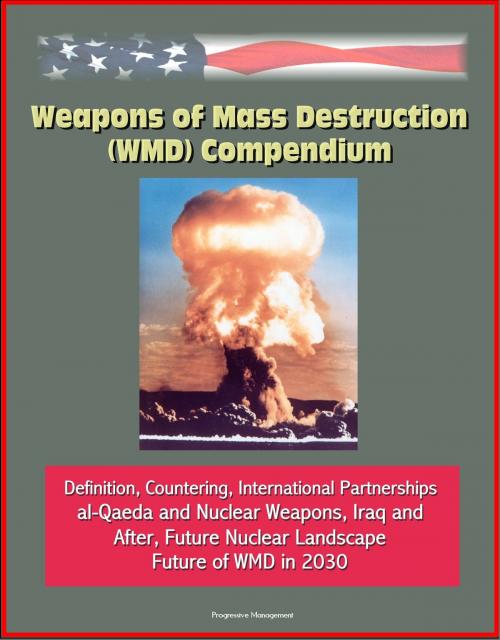Weapons of Mass Destruction (WMD) Compendium: Definition, Countering, International Partnerships, al-Qaeda and Nuclear Weapons, Iraq and After, Future Nuclear Landscape, Future of WMD in 2030
Nonfiction, History, Military, Nuclear Warfare, Social & Cultural Studies, Political Science| Author: | Progressive Management | ISBN: | 9781311374318 |
| Publisher: | Progressive Management | Publication: | February 25, 2016 |
| Imprint: | Smashwords Edition | Language: | English |
| Author: | Progressive Management |
| ISBN: | 9781311374318 |
| Publisher: | Progressive Management |
| Publication: | February 25, 2016 |
| Imprint: | Smashwords Edition |
| Language: | English |
Professionally converted for accurate flowing-text e-book format reproduction, this unique book is a compendium of eight outstanding reports from the Center for the Study of Weapons of Mass Destruction (WMD Center). The reports include:
Part 1: Defining "Weapons of Mass Destruction" * Part 2: Countering Weapons of Mass Destruction: Looking Back, Looking Ahead * Part 3: International Partnerships to Combat Weapons of Mass Destruction * Part 4: Can al Qaeda Be Deterred from Using Nuclear Weapons? * Part 5: Eliminating Adversary Weapons of Mass Destruction: What's at Stake? * Part 6: Iraq and After: Taking the Right Lessons for Combating Weapons of Mass Destruction * Part 7: The Future Nuclear Landscape * Part 8: The Future of Weapons of Mass Destruction: Their Nature and Role in 2030
The phrase "weapons of mass destruction, "for example, is an amorphous one, changing meaning according to the whims of the speaker. Raising the specter of WMD is more a way by which politicians assign blame or take a stand on seemingly objective moral standards than a way by which they assess a particular weapons system. Because many analysts find fault with existing definitions, they offer new definitions that differ in some radical way from those commonly accepted.8 Still others, believing that the traditional definitions for WMD are intellectually problematic, propose dropping the term altogether. Recognizing these disagreements, the 2004 British government review of Iraq WMD intelligence offered the following comment: There is a considerable and long-standing academic debate about the proper interpretation of the phrase "weapons of mass destruction." We have some sympathy with the view that, whatever its origin, the phrase and its accompanying abbreviation is now used so variously as to confuse rather than enlighten readers.
In important ways, the world is at a nuclear crossroads. The complex and dynamic nuclear landscape presents us with challenges along at least four axes: regional nuclear proliferation, nuclear terrorism, great power nuclear relations, and the security implications of increased interest in nuclear energy. These problems are interrelated in ways that the national security community does not fully understand. Strategy and policy frameworks do not address them in sufficiently integrated fashion. New conceptual thinking is required to develop a more unified understanding of and approach to managing the risks and opportunities posed by these 21st-century nuclear challenges.
Today, more than at any other time in the nuclear era, nuclear capacity and potential (knowledge, technology, and materials) are accessible to a growing number of actors with more ambitious goals. The result is a high degree of nuclear latency that challenges traditional thinking about nuclear threats. Whereas 30 or 40 years ago, only a handful of countries were assumed to know how to acquire nuclear weapons, as many as 35 or 40 nations currently are believed to be in the know, and many more could become so based on their participation in civilian nuclear energy programs.
Professionally converted for accurate flowing-text e-book format reproduction, this unique book is a compendium of eight outstanding reports from the Center for the Study of Weapons of Mass Destruction (WMD Center). The reports include:
Part 1: Defining "Weapons of Mass Destruction" * Part 2: Countering Weapons of Mass Destruction: Looking Back, Looking Ahead * Part 3: International Partnerships to Combat Weapons of Mass Destruction * Part 4: Can al Qaeda Be Deterred from Using Nuclear Weapons? * Part 5: Eliminating Adversary Weapons of Mass Destruction: What's at Stake? * Part 6: Iraq and After: Taking the Right Lessons for Combating Weapons of Mass Destruction * Part 7: The Future Nuclear Landscape * Part 8: The Future of Weapons of Mass Destruction: Their Nature and Role in 2030
The phrase "weapons of mass destruction, "for example, is an amorphous one, changing meaning according to the whims of the speaker. Raising the specter of WMD is more a way by which politicians assign blame or take a stand on seemingly objective moral standards than a way by which they assess a particular weapons system. Because many analysts find fault with existing definitions, they offer new definitions that differ in some radical way from those commonly accepted.8 Still others, believing that the traditional definitions for WMD are intellectually problematic, propose dropping the term altogether. Recognizing these disagreements, the 2004 British government review of Iraq WMD intelligence offered the following comment: There is a considerable and long-standing academic debate about the proper interpretation of the phrase "weapons of mass destruction." We have some sympathy with the view that, whatever its origin, the phrase and its accompanying abbreviation is now used so variously as to confuse rather than enlighten readers.
In important ways, the world is at a nuclear crossroads. The complex and dynamic nuclear landscape presents us with challenges along at least four axes: regional nuclear proliferation, nuclear terrorism, great power nuclear relations, and the security implications of increased interest in nuclear energy. These problems are interrelated in ways that the national security community does not fully understand. Strategy and policy frameworks do not address them in sufficiently integrated fashion. New conceptual thinking is required to develop a more unified understanding of and approach to managing the risks and opportunities posed by these 21st-century nuclear challenges.
Today, more than at any other time in the nuclear era, nuclear capacity and potential (knowledge, technology, and materials) are accessible to a growing number of actors with more ambitious goals. The result is a high degree of nuclear latency that challenges traditional thinking about nuclear threats. Whereas 30 or 40 years ago, only a handful of countries were assumed to know how to acquire nuclear weapons, as many as 35 or 40 nations currently are believed to be in the know, and many more could become so based on their participation in civilian nuclear energy programs.















